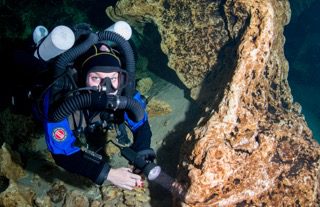By: Kerry Freeland / Dive Pros
I was recently forced to ride my motorcycle to work on a cold blustery day. My pickup was in for needed repairs and the rain was not slowing my ever-growing pile of things that needed attention. As I gracefully age, I have found that what used to be lagniappe comforts have become pretty much a necessity, like, being warm. Harkening back to my youth, when two wheels were all I had, I put on some leather, covered my skin with appropriate clothing and took off. Due to my previous experiences and having the right gear, I was warm. The wind, the rain, the cold, all bounced off me; I was warm. Most people would look at me and think I was probably freezing, but nay, I was warm. I reference this experience because it is the same scenario when one is diving in colder water. With the proper experience and the right gear, you too can be warm.
Wetsuits are wonderful things, they fit tightly and come in differing thicknesses to accommodate the water temperature that you will be diving in. A wetsuit allows water to contact your skin and you warm it, they are tight so that the water does not circulate out of the wetsuit. The thickness of the suit provides the insulation between that warmed water and the outside. The problem is that when you add to the thickness of the neoprene, you reduce your mobility. It becomes harder to move because you are working against the wetsuit, it wants to retain it original shape, but you want to bend your elbows. Additionally, you must add more weight to submerge this thicker neoprene wetsuit. Caribbean water temperature suits come in 0.5mm thickness to 3 mm thickness. In the Gulf of Mexico our temperatures vary enough that a 3 mm wetsuit just won’t cut it in the cooler months. When the water gets into the low seventies and sixties most people need more insulation. In the winter months, we at Dive Pros sell 5 mm wetsuits. They provide enough protection for most of our Northern Gulf of Mexico temperatures. In addition, you can layer up with vests and hoods to keep you warmer for shallower waters, which tend to be cooler. Over the years we have tried thicker wetsuits, but the consensus is that people don’t really like anything thicker than the 5 mm when it comes to mobility and comfort.
But if you’re like me, and you really want to be warm, let’s talk drysuits. A drysuit is just that, you don’t get wet. There are seals at the wrist and on your neck that keep the water out of the suit. Your body does not have to warm a layer of water. Your body is nice and cozy inside a fleece unisuit underneath the drysuits outer shell. Of course, you could always swim up to Holiday parties with your tuxedo underneath, like James Bond. But seriously, you never get wet, and thus your body does not have to use as much energy to stay warm. A drysuit fits looser, allowing for varying thickness of insulation to be worn underneath. The colder the water, the thicker the insulating suit, or underwear, would be. Because a drysuit fits loosely it can pinch you as you descend. If the folds of material happen to catch your skin as you go down the increased pressure will pinch your skin. Therefore, we have a valve on the suit to add air to the suit and another to vent the air from the suit. By adding a bit of air into the drysuit, you relieve the pressure against your body and the suit moves off you. The thickness of the underwear is not the only insulating factor. The different materials that the drysuit is made of will have an effect as well. There are some neoprene and crushed neoprene drysuits that inherently require less insulation to be worn underneath. My first drysuit was a neoprene suit that fit pretty snug, it was good for my first experience as it did not require much insulation but did require a lot of weight to submerge.
Nowadays drysuits have become much more sophisticated. They have even come down in price.
It used to be that when the seals on the wrist or neck wore out, you had to send it off to a repair facility and have a new set glued into the suit. Many of the new suits now have the ability to remove and replace the wrist or neck seals in the field, by the owner. This is a huge improvement over the older drysuits. Over the years Dive Pros has sold every major brand of drysuit available. These days the leader must be Diving Unlimited International, otherwise known as DUI. DUI has led the way with replaceable seals, heavy duty materials that are very pliable for comfort, and now they offer lower cost drysuits with these desirable features. There was a time when the potential drysuit owner had to be prepared to shell out thousands of dollars to be warm and cozy in these cooler waters. Now the prices have dropped to about $1500.00 for a quality drysuit with replaceable seals. Once only the realm of commercial divers, public safety teams, and those with big budgets, drysuit ownership is now within the reach of the masses. Give Dive Pros a call, give your shop a call, we can get you the proper gear and the proper training to keep you warm and cozy under the waves, all year long.
For more information, contact Dive Pros at #850-456-8845


